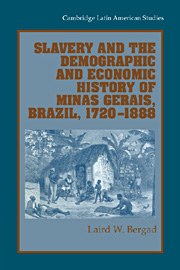Book contents
- Frontmatter
- Contents
- List of illustrations
- List of tables
- Preface
- Acknowledgments
- Maps
- 1 The mining-driven economy and its demise: from settlement to 1808
- 2 Economic transformations, 1808–1888
- 3 Demographic rhythms from settlement to the census of 1872
- 4 Demographic aspects of slavery, 1720–1888
- 5 Economic aspects of slavery, 1720–1888
- 6 Conclusions
- Appendixes
- Glossary
- Bibliography
- Index
6 - Conclusions
Published online by Cambridge University Press: 16 February 2010
- Frontmatter
- Contents
- List of illustrations
- List of tables
- Preface
- Acknowledgments
- Maps
- 1 The mining-driven economy and its demise: from settlement to 1808
- 2 Economic transformations, 1808–1888
- 3 Demographic rhythms from settlement to the census of 1872
- 4 Demographic aspects of slavery, 1720–1888
- 5 Economic aspects of slavery, 1720–1888
- 6 Conclusions
- Appendixes
- Glossary
- Bibliography
- Index
Summary
As the mining boom developed during the first half of the eighteenth century, the foundations of future Mineiro social and economic structures emerged. Mining was the axis around which economic life turned, but it was accompanied by the growth of a fairly large-scale pastoral sector in every region where mineral deposits were found. Animals roamed natural pastures, to be rounded up when needed and slaughtered for meat, hides, and a variety of by-products. Agricultural production also emerged, revolving largely around the cultivation of dietary staples such as corn and manioc root and their processing into flour. These products were supplemented by the production of a wide variety of garden vegetables. Sugar cane cultivation and the production of pinga and rapaduras for local markets, not for export, also developed on a significant scale in all regions. Cotton production, which would develop in a number of districts as the mining boom ended, was not yet a major activity. Nor was the manufacture of textiles, another future mainstay of the Mineiro economy. Tobacco farming was still fairly marginal, and coffee would be introduced only in the second half of the eighteenth century.
The production of food was at first motivated by the pressing need for sustenance, since the mining districts were too far from coastal regions of settlement to depend upon imports. As markets for food and for the byproducts of ranching developed with population growth and the establishment of urban administrative centers, animal raising and agriculture became important rural-based commercial activities.
- Type
- Chapter
- Information
- Publisher: Cambridge University PressPrint publication year: 1999



